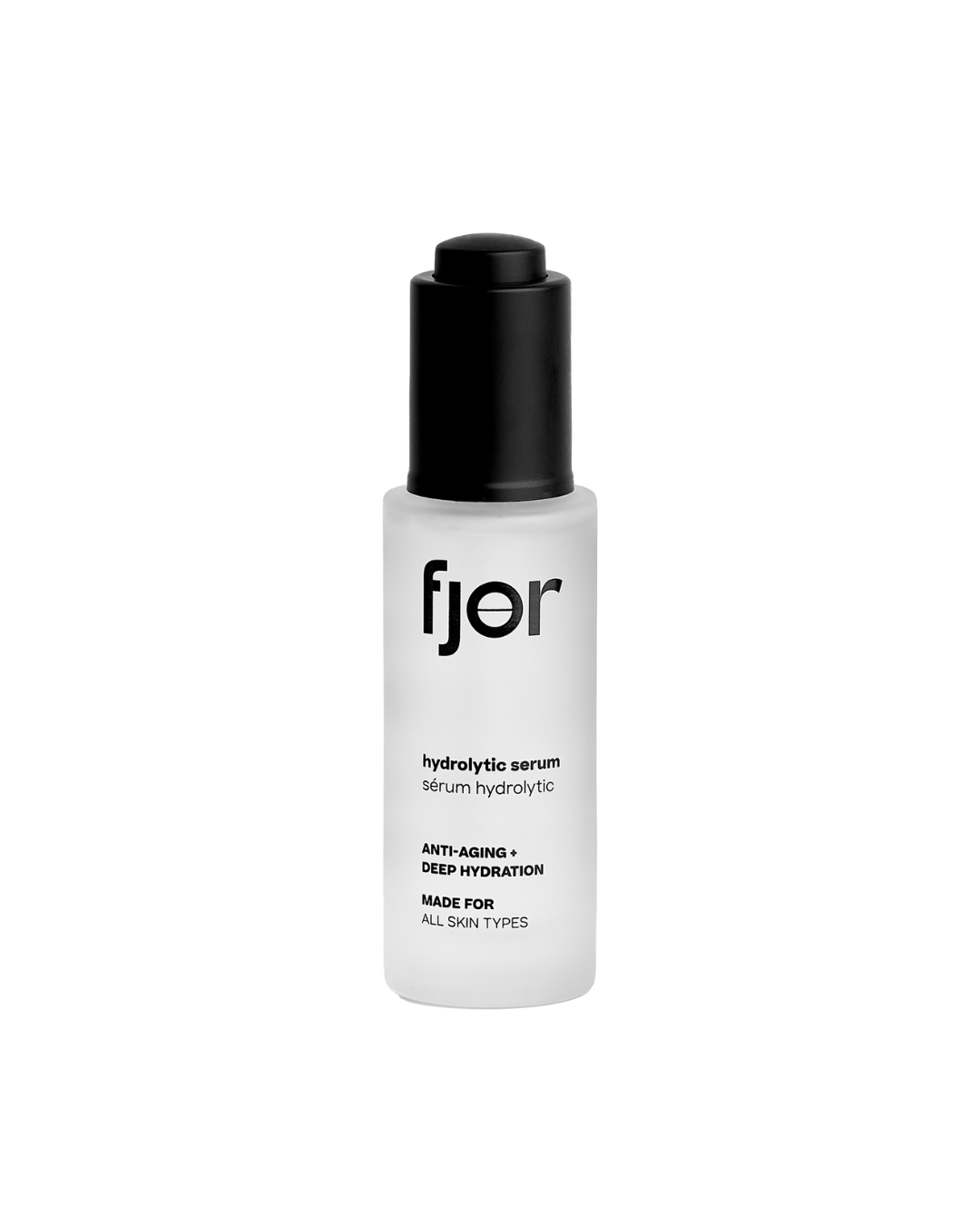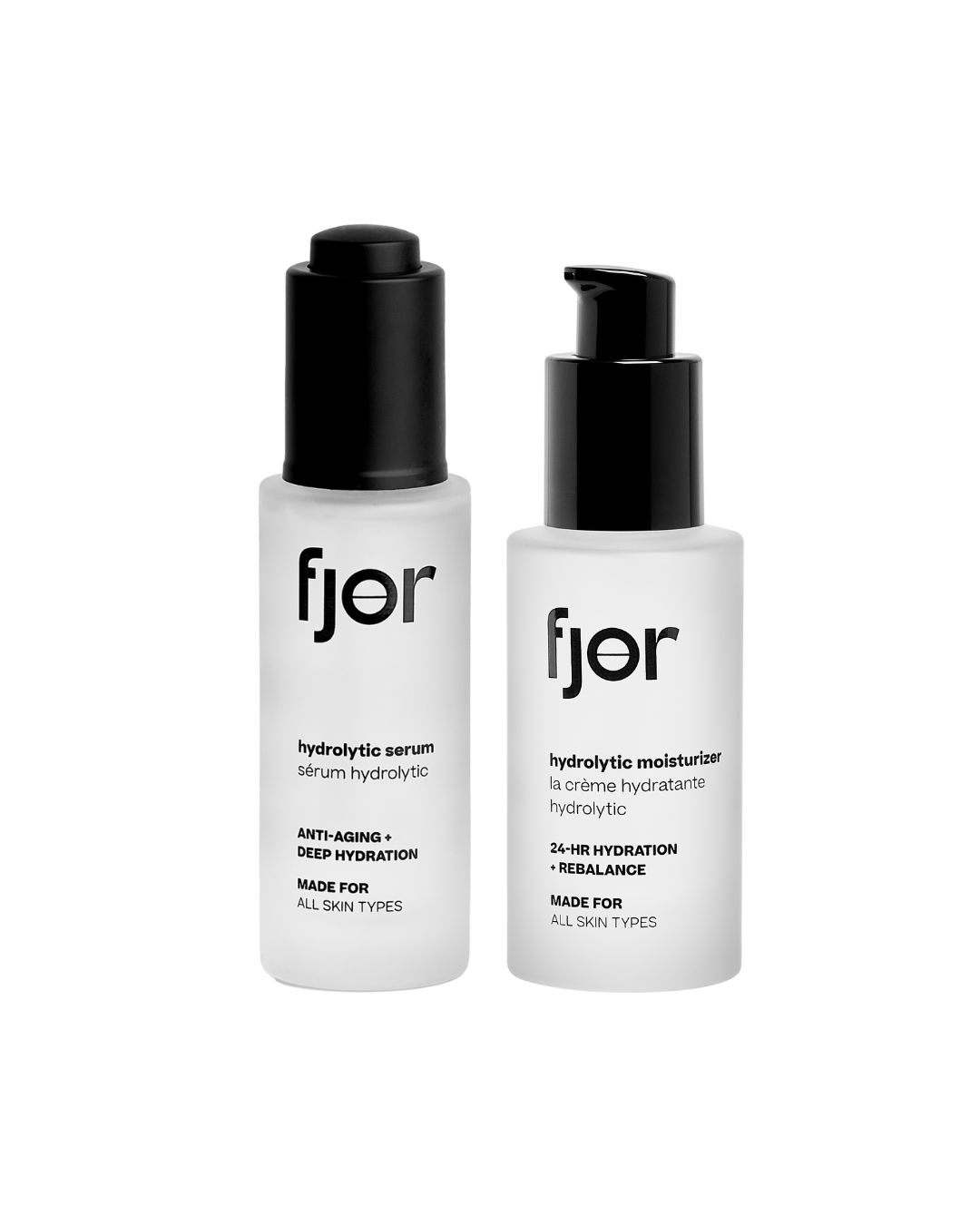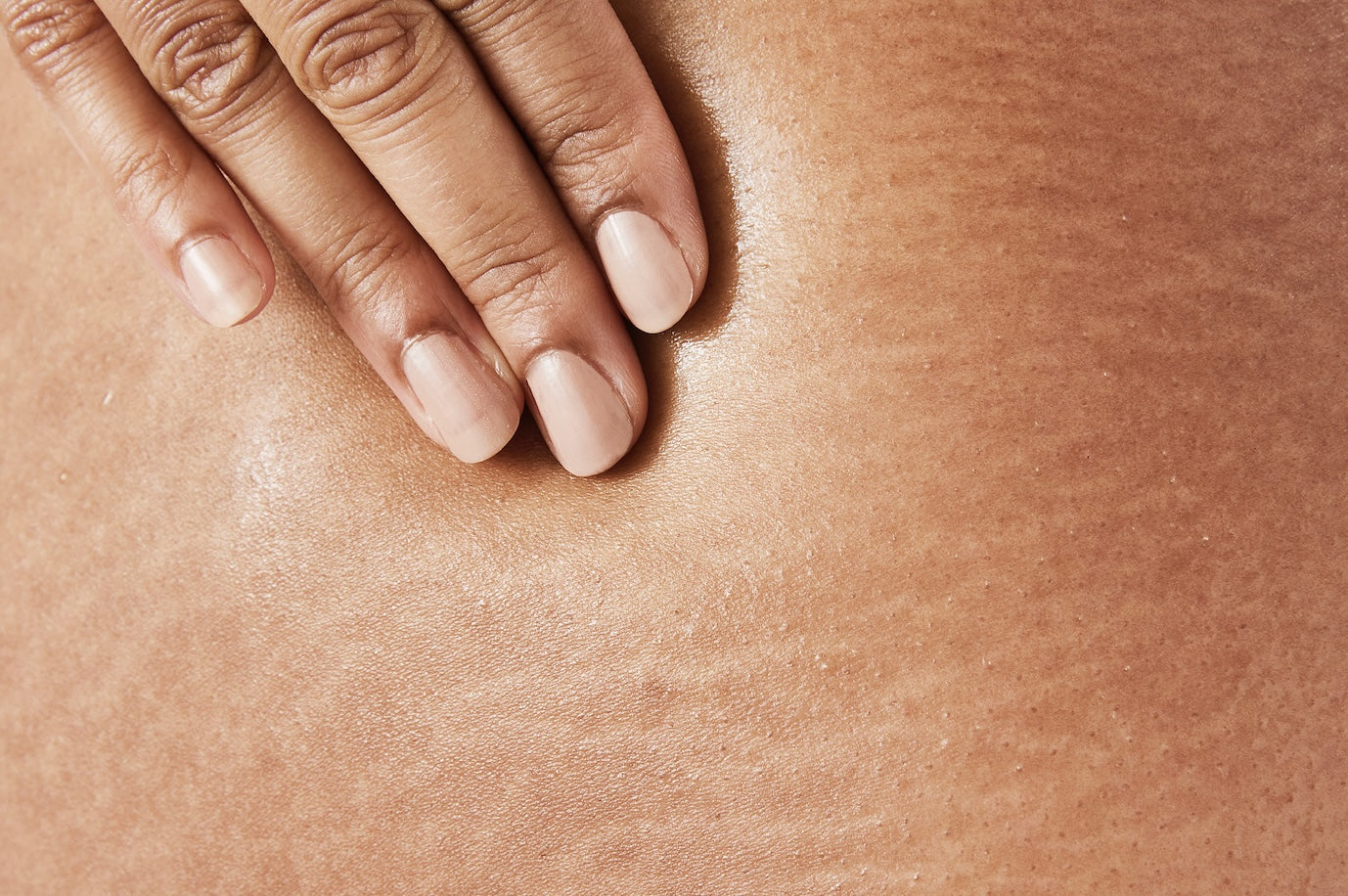Is Sauna Good for Your Skin? Benefits, Anti-Aging, and Hydration



Cart (0)
Your cart is empty
Continue ShoppingFeb 24, 2025
Is Sauna Good for Your Skin? Benefits, Anti-Aging, and Hydration
Saunas have been a part of wellness routines for centuries, but what do they actually do for your skin? If you’ve ever stepped out of a sauna with a fresh, dewy glow, you’ve probably wondered whether that’s just temporary or if there are lasting benefits. Let’s break down how sauna sessions affect skin health, what types of saunas exist, and which one might be best for you.

Contents of this article
- Types of Sauna for Skin
- What is the Best Sauna for Your Skin Type?
- What Are the Skin Benefits of Sauna?
- How to Sauna for Better Skin
- Does Sauna Help with Skin Conditions?
- Are There Any Drawbacks from Sauna?
- Can I Wear Skincare in the Sauna?
- Hydrolytic® Serum
- What Skincare Should You Use After a Sauna?
- The Hydrolytic® Duo
- Conclusion
- Your Questions, Our Priority
Key takeaways from this article
- Sauna use can enhance skin hydration, improve circulation, and stimulate collagen production for anti-aging benefits.
- Different sauna types provide distinct benefits, such as steam saunas for hydration and infrared saunas for skin elasticity.
- Regular sauna sessions help clear pores and support overall detoxification.
- After a sauna, wash and hydrate your skin, and use sun protection during daytime.
- Those with sensitive skin or skin conditions should consult a dermatologist before starting a sauna routine.
Types of Sauna for Skin
Saunas come in different forms, each offering unique benefits for your skin. Whether you're looking to boost hydration, improve circulation, or support collagen production, choosing the right type of sauna can make all the difference. Some saunas provide deep detoxification, while others are gentler and more hydrating. Understanding how each one works will help you find the best fit for your skin type and skincare goals.
- Traditional Dry Sauna Uses heated stones to create dry heat around 70-90°C, making you sweat without additional humidity.
- Steam Sauna (Steam Room or Hammam) A high-humidity environment with temperatures around 40-50°C, which feels hotter due to moisture in the air.
- Infrared Sauna Uses infrared light to heat the body directly, operating at 45-60°C but penetrating deeper into the skin.
- Facial Sauna A smaller, targeted steam sauna designed specifically for facial skin, often used for deep cleansing.
What is the Best Sauna for Your Skin Type?
Choosing the right sauna for your skin type can make all the difference. While all saunas offer benefits, certain types work better for specific skin concerns. Here’s how to find the best sauna for your skin.
- Dry skin Steam sauna helps replenish moisture and supports the skin barrier, preventing excessive dehydration.
- Combination skin Alternating between steam sauna for hydration and dry sauna for detox can help balance both oily and dry areas.
- Normal skin Any type of sauna can be beneficial, try to combine them all or just stick to your favourite.
- Oily skin Traditional dry sauna increases sweat production to help clear overly oily skin.
- Clogged pores Steam sauna or a face sauna softens debris in the pores, making it easier to remove blackheads and congestion.
- Aging skin Infrared sauna boosts collagen production, improves skin elasticity, and reduces the appearance of fine lines and wrinkles.
What Are the Skin Benefits of Sauna?
A sauna session does more than just make you sweat. It has science-backed benefits for your skin. Here’s how regular sauna use can improve skin health
- Hydration Research shows that sauna helps retain water in the skin barrier and increases skin's ability to recover from water loss. It also increases the skin barrier's ability to prevent water loss. This means regular sauna can increase your skin's hydration capabilities.
- Anti-Aging & Collagen Production Research shows that far-infrared (FIR) exposure for 15–20 minutes, five times a week for six months can lead to a 20–50% improvement in wrinkles, skin texture, and tone. Studies have found that FIR stimulates fibroblast activity, increasing collagen and elastin production, which helps maintain firm, youthful skin and supports skin regeneration over time. Many infrared saunas primarily use FIR, providing gentle, heat-based therapy that can support skin health when used correctly. However, not all infrared exposure is beneficial. Some infrared sources, particularly near-infrared (NIR), penetrate deeper into the skin and, with excessive or frequent exposure, may contribute to collagen breakdown and premature skin aging. To see benefits without damaging the skin, it’s important to check what type of infrared your sauna emits and to follow a recommended schedule. Overexposure or improper use of IR therapy can have the opposite effect, so controlled, consistent exposure is key.
- Improved Blood Circulation & Skin Tone Sauna enhances blood flow to skin cells. This increased blood flow supports skin function and complexion. Studies suggest that regular sauna sessions can improve skin texture and tone over time, contributing to the healthy, natural "sauna glow."
- Lymphatic Drainage & Detoxification Encourages lymphatic drainage, reducing puffiness and flushing out toxins. Supports the body's natural detox process by increasing sweat production. Removes built-up pollutants and heavy metals from the blood.
- Clears Pores & Reduces Acne Opens pores, making it easier to remove blackheads and dirt. Increases sweat gland activity, which helps flush out bacteria that contribute to breakouts. Reduces excess oil production, which is a common trigger for acne.
- Strengthens the Skin Barrier Regular sauna use enhances the skin’s natural defenses by improving its surface pH and increasing the water-holding capacity of the stratum corneum, helping to prevent dryness and strengthen resilience against environmental stressors.
- Reduces Inflammation Long-term sauna studies have shown sauna's ability to reduce inflammation across the body. Studies are yet to connect these anti-inflammatory effects to the skin, but it is highly possible that they exist.
How to Sauna for Better Skin
A sauna session can be a powerful part of your skincare routine if done right. Here’s how to make the most of it.
- Ideal steam temperatures are 70-90°C for a dry sauna and 40-50°C for a steam sauna. For an IR sauna, the type of IR radiation is key. Make sure you are using Far Infrared (FIR) not Near Infrared (NIR). Ensure you do not overexpose yourself outside of the recommended limits.
- Shower off any dirt before entering the sauna.
- Drink a lot of water to prevent dehydration. Water with electrolytes would be optimal.
- A sauna session should typically last 10–20 minutes to achieve optimal skin benefits.
- After a sauna, shower off with lukewarm/cold water to remove any dirt and close your pores.
- To prevent dry skin, apply a moisturizer to fortify your skin barrier.
- Using a sauna 2-3 times a week is optimal for skin benefits.

Does Sauna Help with Skin Conditions?
Many people with skin conditions wonder if sauna use is safe. Here’s how different skin types and conditions react.
- Eczema There is no scientific research on the effects of sauna on eczema. General information states that it can be acceptable if your skin barrier is intact but otherwise may cause irritation and redness. Research has linked sweating to the release of natural peptides that prevent bacteria overgrowth related to eczema. However, sweating may irritate a weakened skin barrier which could increase pathogen overgrowth. More research needs to be done to understand this. If you do want to try, discuss this with your dermatologist and approach with caution.
- Psoriasis Once again, scientific research is sparse. However, one study noted that of 213 male psoriasis patients, 88% reported no impact from sauna use, 11% saw an improvement, and 1% saw their condition worsen. Another study stated that sauna could facilitate the "removal of hyperkeratotic scales". If you do want to try, discuss this with your dermatologist and approach with caution.
- Rosacea The connections between sauna and rosacea are not well researched. Additionally, we found no research on the benefits of sweating for rosacea. We always keep an ear on the science and update our community through our newsletter.
- Seb Derm Many online articles state benefits for seborrheic dermatitis. Some state that increased sweating during the sauna can cause an increase in Malassezia. We found no direct evidence or research linking seb derm improvements or flare ups with sauna use. While research has not been done, we can still theorise that the proven benefit of sauna to reduce skin sebum may help seb derm sufferers. If you do want to try, discuss this with your dermatologist and approach with caution.
- Acne Other online articles state that sauna could potentially be good for cleaning the skin and pores. Let's look at the scientific evidence. Acne and the benefits of sauna are not well understood, but here is what we found. Research shows that sauna can decrease sebum levels and increase your barrier function. Other research shows that sweat is rich in antimicrobial peptides, which inhibit acne related bacteria production. This suggests that increased sweating—like from sauna use—may help suppress acne's overgrowth. If you do want to try, discuss this with your dermatologist and approach with caution.
- Dry Skin Research shows that frequent sauna can strengthen the skin barrier and increase skin barrier hydration. Make sure to moisturize after, and you should feel benefits.
- Contact Dermatitis For those with frequent skin allergies, we wanted to note that some people have had allergic reactions to the wood used in traditional saunas. Make sure to patch test if you are at risk.
Are There Any Drawbacks from Sauna?
Saunas offer multiple scientifically studied skin benefits, including strengthening the skin barrier, reducing excess sebum, and even increasing hydration by enhancing circulation. Regular sauna use can support a healthier complexion by promoting detoxification and boosting moisture retention. However, excessive heat exposure or prolonged sessions can sometimes lead to temporary dryness, especially if hydration isn’t maintained. Those with sensitive skin or conditions may need to moderate their use, as heat can trigger flare-ups. To maximize the benefits while minimizing any drawbacks, it’s best to stay well-hydrated, keep sessions moderate, and follow up with a nourishing skincare routine.
Can I Wear Skincare in the Sauna?
Yes, you can typically wear skincare products in the sauna, but choosing the right ingredients is important. The heat and humidity cause your skin to sweat, which can enhance the activity and effectiveness of certain active ingredients. For example, actives like the Hydrolytic Enzyme become more effective in the presence of sweat, as the moisture activates and increases enzymatic activity, boosting their skincare benefits. However, other actives like retinol or exfoliating acids may irritate the skin when combined with heat and sweat. Always consult a dermatologist to confirm which products are safe and beneficial for your sauna routine.

Hydrolytic® Serum
Lightweight anti-aging treatment
What Skincare Should You Use After a Sauna?
After a sauna session, your skin is perfectly primed to absorb hydrating and soothing ingredients. Here’s what to apply for optimal post-sauna skincare:
Gentle Cleanser or Wash:
Start with a mild, hydrating cleanser to remove sweat and impurities without stripping your skin. Avoid harsh or exfoliating cleansers, as your skin may be more sensitive after heat exposure.
Hydrating Serum:
Apply a lightweight, water-based serum to replenish lost moisture and support your skin’s hydration levels.
Calming Moisturizer:
Follow up with a soothing, hydrating moisturizer to lock in moisture and reinforce your skin barrier. A simple, nourishing formula will help maintain the skin’s balance after heat exposure.
Sun Protection:
If your sauna session occurs during the day, finish with a broad-spectrum SPF 30 or higher. Sauna heat can temporarily make your skin more sensitive to UV rays, so sun protection is essential.
By focusing on hydration and barrier support, you can maximize the skin benefits of sauna sessions while preventing dryness or irritation.

The Complete Routine
Hydrolytic® Serum + Moisturizer
Conclusion
We have seen that frequent sauna use provides many proven benefits for skin health, function, and appearance.
We believe that sauna is a key pillar in achieving optimal skin barrier function, hydration, and texture.
We always keep an ear on the science and update our community through our newsletter. Sign up if you would like to receive optimal skin hacks.
Your Questions, Our Priority
How often should you use a sauna for skin benefits?
Generally, using a sauna 2–3 times per week is optimal for skin benefits, providing hydration, improving circulation, and supporting overall skin health.
Should you shower immediately after using a sauna?
Yes, it's best to rinse off with lukewarm or cool water immediately after the sauna to remove sweat and impurities, close your pores, and prevent skin irritation.
Is it safe to wear makeup in a sauna?
No, it's best to remove makeup before using a sauna, as makeup can clog pores and trap bacteria, potentially causing irritation or breakouts.
Should I drink water before, during, or after the sauna?
You should drink water before, during, and after your sauna session. Staying hydrated helps maintain skin hydration, prevents dehydration, and supports detoxification.
Is sauna safe for sensitive skin?
Saunas can be safe for sensitive skin if used cautiously. Limit your sessions, keep temperatures moderate, and always apply soothing, fragrance-free skincare products afterward. If concerned, consult your dermatologist first.
What is fjör?
fjör is a microbiome skincare brand from Scandinavia, designed to boost skin health by enhancing microbiome diversity. Using innovative Hydrolytic® Enzyme technology, fjör supports sensitive skin with a minimalist approach, focusing on resilience, hydration, and balance for a naturally radiant complexion.
What is the skin barrier, and why is it important?
The skin barrier, also known as the stratum corneum, is the outermost layer of the skin that acts as a protective shield. It prevents water loss, keeps out harmful substances, and supports skin health. A damaged barrier can lead to dryness, irritation, and increased sensitivity to external stressors.
What is microbiome diversity, and why does it matter for skin health?
Microbiome diversity refers to the variety of microorganisms, such as bacteria and fungi, living on the skin. A diverse microbiome helps protect the skin from harmful pathogens, reduce inflammation, and maintain overall skin health. Low diversity can contribute to sensitivity, redness, and other skin issues.
Authors

Written by William Smithwite
Co-founder of fjör & Skin Microbiome Expert

Reviewed by Natalie Enslöw
Founder & CEO of fjör
References
- Kowatzki, D., et al. "Effect of Regular Sauna on Epidermal Barrier Function and Stratum Corneum Water-Holding Capacity in Vivo in Humans: A Controlled Study." Dermatology, vol. 217, no. 2, 2008, pp. 173-180, karger.com/drm/article/217/2/173/111884.
- Lee, Ju Hee, Mi Ryung Roh, and Kwang Hoon Lee. "Effects of Infrared Radiation on Skin Photo-Aging and Pigmentation." Yonsei Medical Journal, vol. 47, no. 4, 2006, pp. 485-490, synapse.koreamed.org/pdf/10.3349/ymj.2006.47.4.485.
- Cho, Soyun, et al. "Effects of Infrared Radiation and Heat on Human Skin Aging in Vivo." Journal of Investigative Dermatology Symposium Proceedings, vol. 14, no. 1, Elsevier, 2009, pp. 15-19, sciencedirect.com/science/article/pii/S1087002415305049.
- Laukkanen, Jari A., Tanjaniina Laukkanen, and Setor K. Kunutsor. "Cardiovascular and Other Health Benefits of Sauna Bathing: A Review of the Evidence." Mayo Clinic Proceedings, vol. 93, no. 8, Elsevier, 2018, pp. 1111-1121, mayoclinicproceedings.org/article/s0025-6196%2818%2930275-1/fulltext.
- Cecchini, Marie, and Vincent LoPresti. "Drug Residues Store in the Body Following Cessation of Use: Impacts on Neuroendocrine Balance and Behavior–Use of the Hubbard Sauna Regimen to Remove Toxins and Restore Health." Medical Hypotheses, vol. 68, no. 4, 2007, pp. 868-879, www.fasenet.org/wp-content/uploads/2018/07/Medical_Hypotheses_2006.pdf.
- Cecchini, Marie, and Vincent LoPresti. "Drug Residues Store in the Body Following Cessation of Use: Impacts on Neuroendocrine Balance and Behavior–Use of the Hubbard Sauna Regimen to Remove Toxins and Restore Health." Medical Hypotheses, vol. 68, no. 4, 2007, pp. 868-879, pmc.ncbi.nlm.nih.gov/articles/PMC3312275/.
- Kunutsor, Setor K., Tanjaniina Laukkanen, and Jari A. Laukkanen. "Longitudinal Associations of Sauna Bathing with Inflammation and Oxidative Stress: The KIHD Prospective Cohort Study." Annals of Medicine, vol. 50, no. 5, 2018, pp. 437-442, tandfonline.com/doi/full/10.1080/07853890.2018.1489143.
- Huilaja, L., M. E. Kubin, and R. Riekki. "Contact Allergy to Finished Woods in Furniture and Furnishings: A Small Allergic Contact Dermatitis Epidemic to Western Red Cedar in Sauna Interior Decoration." Journal of the European Academy of Dermatology and Venereology, vol. 30, no. 1, 2016, pp. 57-59, onlinelibrary.wiley.com/doi/abs/10.1111/jdv.12937.
- Laukkanen, Jari A., Tanjaniina Laukkanen, and Setor K. Kunutsor. "Cardiovascular and Other Health Benefits of Sauna Bathing: A Review of the Evidence." Mayo Clinic Proceedings, vol. 93, no. 8, Elsevier, 2018, pp. 1111-1121, sciencedirect.com/science/article/pii/S0025619618302751.
- Hannuksela, Minna L., and Samer Ellahham. "Benefits and Risks of Sauna Bathing." The American Journal of Medicine, vol. 110, no. 2, 2001, pp. 118-126, researchgate.net/profile/Samer-Ellahham/publication/12163683_Benefits_and_risks_of_sauna_bathing/links/53edd9750cf2981ada17315b/Benefits-and-risks-of-sauna-bathing.pdf.
- Ständer, M., and B. Steinsland. "Psoriasis Patients in the Sauna." Der Hautarzt; Zeitschrift fur Dermatologie, Venerologie, und Verwandte Gebiete, vol. 34, no. 10, 1983, pp. 512-514, europepmc.org/article/med/6643057.
- Nakano, Toshiaki, et al. "Reduced Expression of Dermcidin, a Peptide Active against Propionibacterium Acnes, in Sweat of Patients with Acne Vulgaris." Acta Dermato-Venereologica, vol. 95, no. 7, 2015, pp. 783-786, pubmed.ncbi.nlm.nih.gov/25673161/.
- Rieg, Siegbert, et al. "Deficiency of Dermcidin-Derived Antimicrobial Peptides in Sweat of Patients with Atopic Dermatitis Correlates with an Impaired Innate Defense of Human Skin in Vivo." The Journal of Immunology, vol. 174, no. 12, 2005, pp. 8003-8010, pubmed.ncbi.nlm.nih.gov/15944307/.
Contents of this article
- Types of Sauna for Skin
- What is the Best Sauna for Your Skin Type?
- What Are the Skin Benefits of Sauna?
- How to Sauna for Better Skin
- Does Sauna Help with Skin Conditions?
- Are There Any Drawbacks from Sauna?
- Can I Wear Skincare in the Sauna?
- Hydrolytic® Serum
- What Skincare Should You Use After a Sauna?
- The Hydrolytic® Duo
- Conclusion
- Your Questions, Our Priority
Authors

Written by William Smithwite
Co-founder of fjör & Skin Microbiome Expert

Reviewed by Natalie Enslöw
Founder & CEO of fjör


